Introduction to KRAH pipe
What is KRAH pipe? KRAH pipe is high-density polyethylene structural wall thermal winding pipe, HDPE winding structural wall pipe, it is a new type of special-shaped structural wall pipe, made of high-density polyethylene thermal winding molding process. KRAH pipe products are mainly high-density polyethylene resin (HDPE) as raw material, with PP or PE corrugated pipe as auxiliary support pipe, high-density polyethylene large-diameter winding reinforced pipe produced by thermal winding molding process. Because this kind of pipe was originally introduced from the German KRA Company by a domestic company, it is commonly known as KRAH pipe in China. The official name of this kind of pipe in China is: high-density polyethylene structural wall thermal wound pipe, the national standard is GB/T 19472. 2-2004 B-type structural wall pipe. The KRAH pipe product is an environmentally friendly and safe product with the advantages of light weight, strong pressure bearing capacity, high interface quality, long life, corrosion resistance, high ring stiffness, and convenient construction. It is widely used in urban water supply, drainage, long-distance Water delivery and farmland irrigation and other projects. The diameter of the pipe is from DN300-DN4000. The pipe material is light in weight and has good overall flexibility. It is the main pipe material of choice for buried sewage and drainage.
KRAH pipe standards and specifications
KRAH pipe standard
1. Executive standard: German DN16961 standard, GB/T19472.2-2004, CECS164:2004, GB50268-2008
2. KRAH pipe product specifications (mm): DN300, DN400, DN500, DN600, DN700, DN800, DN900, DN1000, DN1100, DN1200, DN1300, DN1400, DN1500, DN1600, DN1700, DN1800, DN1900, DN2000, DN2200, DN2400, DN2500, DN2600, DN2800, DN3000
3. KRAH pipe ring stiffness: up to 20KN/m2 (according to user needs, SN8; SN10; SN12.5; SN16), and the depth of covering soil can reach 20m.
4. The internal pressure level of KRAH pipe: 0.3MPa, the maximum pressure can reach 0.45Mpa.
5. KRAH pipe flexibility: 183m can be coiled into a circle.
KRAH pipe product classification
KRAH pipe products can be divided into three series: PR, OP, SQ, VW, among which: PR, OP-mainly used for buried drainage pipes, SQ-mainly used for making containers or manholes, VW-mainly used for tee, bend The most widely used products are the PR series. The product has a smooth inner surface and a special-shaped reinforced structure on the outside. The standard length of the pipe is 6 meters, and the inner diameter of the pipe ranges from DN300 to DN4000. The product indicators all reach GB /T 19472. 2-2004 B-type structural wall pipe standard and PREN-13476 European standard requirements.
Four, KRAH pipe performance characteristics
The performance characteristics of HDPE winding structure wall pipe (KRAH pipe) are as follows:
1. The quality of the hot winding seam is good
The flat material strips and U-shaped material strips extruded from the die of the extruder in the molten state are evenly wound on the heated drum mold according to the predetermined position, which ensures the quality of the welded seam of the structural wall pipe. Especially in the structural design, the welded seam of the flat material belt is covered by the polyethylene-coated support pipe, which improves the overall external pressure resistance of the product.
2. Excellent installation performance
The pipe connection adopts the socket electric fusion connection technology of the same material as the electric fuse embedded in the socket, and the connection quality is high. It can be 100% leak-free, ensuring the same life of the pipeline system and the safety of operation. At the same time, because the product is lighter than other pipes under the same application conditions, it is easy to transport, convenient and quick to construct, and can reduce construction costs. , Basically, it is done while excavation, pipe down, and backfilling, which simplifies the construction procedure and shortens the construction period. In the acceptance of the project, the closed air test is used instead of the closed water test, which not only speeds up the acceptance speed, but also saves the complicated work and a large amount of test costs in the closed water test.
3. Good flexibility
The high-density polyethylene winding structure wall pipe has good flexibility on the macro level, and the local pipe section has strong rigidity and overall external pressure resistance, which can ensure the safety of traffic when used under the road with overweight load. Due to the flexibility of the pipe, the damage and loss of the pipe can be minimized in the event of geological activities such as earthquakes and uneven settlement on the surface, thereby improving the ability of public facilities to resist earthquakes and reduce disasters.
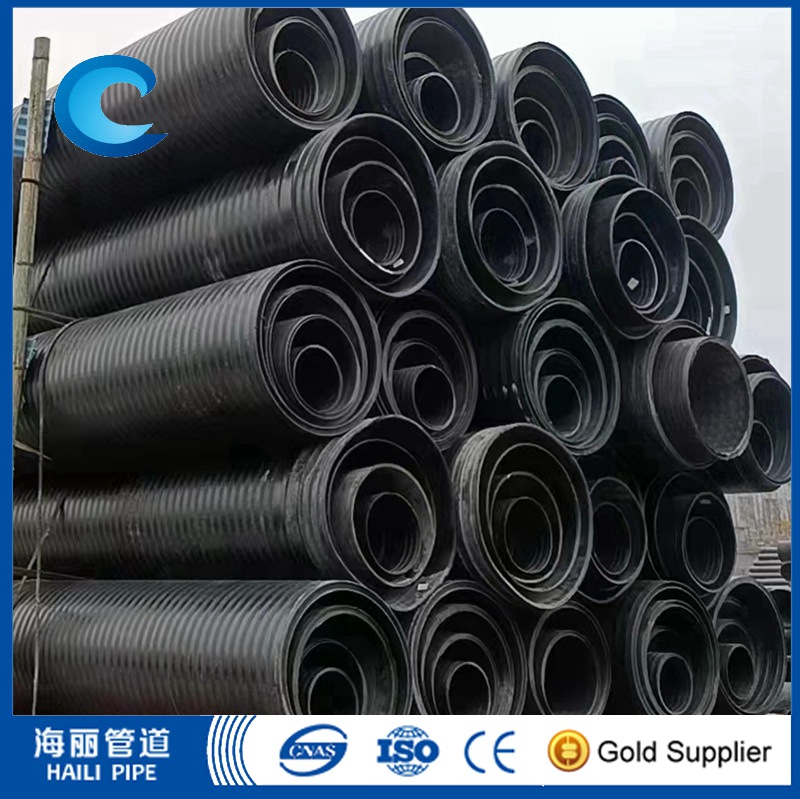
The main production process of KRAH pipe
1. Winding: The molten HDPE flat tape and the PP-coated circular reinforcing rib are simultaneously wound on the steel mold heated to a predetermined temperature
2. Cutting: The pipe socket and socket port are processed to the standard size
3. Demoulding: The pipe is detached from the mold
4. Trimming: make the appearance smooth and standardized
5. Electric fuse pre-embedded: socket pre-embedded electric heating fuse
6. Weighing and inspection: determine product status
The installation process of polyethylene winding structure wall pipe (KRAH pipe)
1. Before the pipes are laid down, they must be inspected section by section according to the product standards. Those who do not meet the standards are strictly prohibited from laying down the pipes.
2. According to the diameter, the groove and the equipment of construction equipment, it is determined that the pipe is placed in the groove by a person or machine. When the pipe is lowered, a reliable spreader must be used to smoothly go down the groove without violent collision with the groove wall and the bottom of the groove. There should be two support points, and two or more of them should not be hung into the groove after welding, and it is strictly forbidden to hang through the heart.
KRAH pipe installation process
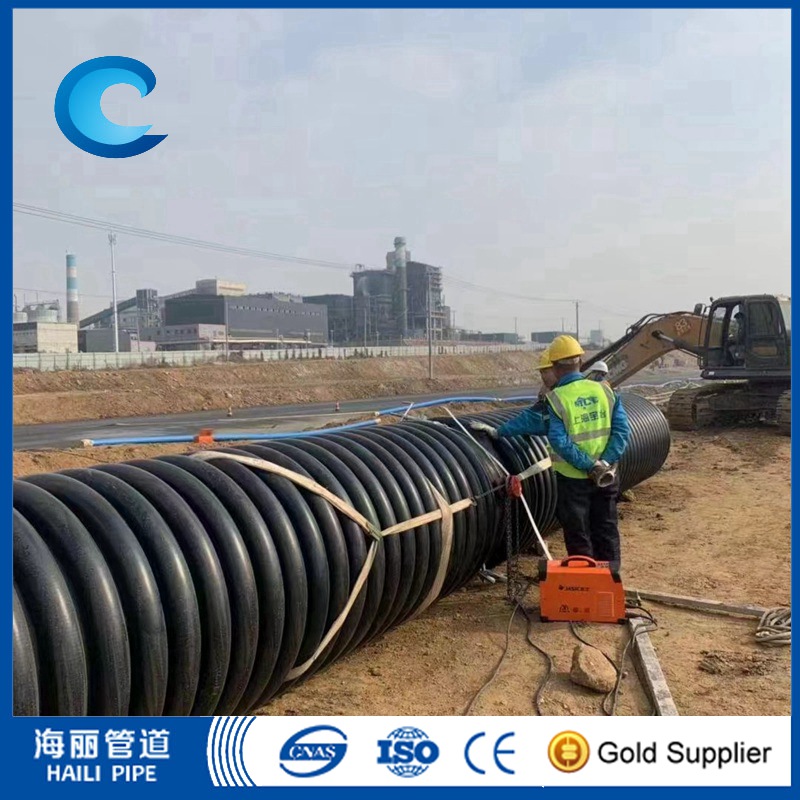
For general soil quality, a layer of medium-sand base layer with a thickness of 100mm should be laid on the undisturbed soil foundation below the bottom of the pipe or the backfilled and compacted foundation; when the soil quality of the soil foundation is poor, a gravel foundation layer with a cushion layer of not less than 200mm can be used It can also be laid in two layers. The lower layer is made of gravel with a particle size of 5-32mm, with a thickness of 100-150mm, and the upper layer is covered with medium-grain sand, with a thickness of not less than 50mm. Or due to construction precipitation and other reasons, the original soil of the foundation is disturbed and the bearing capacity of the foundation is affected. The foundation must be reinforced first, and after reaching the specified bearing capacity of the foundation, a medium-coarse sand foundation layer is laid.
The grooves in the socket joint, mechanical connection and other parts of the pipeline foundation should be dug along with the laying of the pipeline. The length, width and depth of the groove can be determined according to the size of the pipe joint. After the interface, it should be backfilled with medium-coarse sand immediately.
For the section used for pipeline load, changes in stratum soil quality and other factors that may cause uneven longitudinal settlement of the pipeline, the foundation should be reinforced before the pipeline is laid.
The foundation treatment of polyethylene drainage pipes should adopt composite foundation treatment methods such as sand piles and boulder cast-in-place piles. Rigid foundation treatment measures such as driven piles, concrete pads, and concrete strip foundations are not used.
Pipes are installed manually. When the depth of the water is not large, both ends of the pipeline can be lifted manually and passed to the construction workers at the bottom of the water. When the groove is open, the water depth is greater than 3m or the pipe diameter is greater than DN400mm, the non-metal rope can be used to slide the pipe, so that the pipe can be placed on the gravel foundation pipe stably. It is strictly forbidden to use metal ropes to hook the nozzles at both ends or roll the pipe edge into the water. KRAH pipe must transport the pipe to the installation location at the bottom of the water for installation.
The socket and socket pipe should be installed with the socket in the direction of the water flow and the socket in the direction of the water flow, from low to high. The socket shall not remain in the well wall.
During the joint operation, the inner and outer working surfaces of the socket and the socket should be cleaned with a veil, and there should be no debris such as soil and water, and then immediately align the center of the socket end with the center axis of the center pair of the socket in place. Before insertion, the position should be identified according to the insertion depth, so as to judge whether the insertion is in place.
When the socket is inserted into the socket, it is strictly forbidden to hit the pipe body with a hammer, and install it section by section. For pipelines with DN>400mm, cables can be used to tie the pipelines with a manual hoist and other lifting tools for installation.
When the socket is inserted into the socket, according to the KRAH pipe standard design requirements, after the socket is inserted into the 70mm, preheat the copper wire, and then continue to insert the socket after preheating, and finally the socket is completely closed.
Winding pipe, also known as B-type KRAH pipe, the large-diameter HDPE high-density polyethylene winding structure wall pipe is made of high-density polyethylene as the main raw material. The special-shaped rubber strip is extruded out of the machine, and is wound and compounded by a thermoforming machine. The inner and outer walls are smooth and flat, and the specifications are φ300mm~φ3000mm. According to different use conditions, the ring stiffness is divided into five grades, the highest can reach 16KN/m2, and it can adapt to acid and alkali liquids with a concentration of less than 10%.
Winding pipes have the advantages of corrosion resistance, light weight, easy installation, large flow rate, long life and so on. They can replace pipes made of high energy consumption materials (cement, cast iron, ceramics, etc.), and are widely used in highways, municipal construction, residential quarters, Drainage and sewage pipes in agriculture and other fields.
The product is produced in strict accordance with GB/T19472.2-2004 "Buried Polyethylene (PE) Structural Wall Pipe System Part 2: Polyethylene Winding Structural Wall Pipe" to ensure that all aspects of the product are under control.
KRAH pipe structure
1. Pipe diameter
The diameter of KRAH pipe can be from 300mm to 4000mm, and the diameter of two adjacent pipes can be different by 100mm. The nominal diameter of KRAH pipe is the inner diameter of the pipe, so when the ring stiffness or wall thickness of the pipe changes, the inner diameter of the pipe does not change, thus Make sure that the water flow is not affected.
KRAH pipe diameter
2. Pipe structure
The nominal length of KRAH pipe is generally 6 meters. The body of KRAH pipe is divided into three parts, the first part is the socket, the second part is the main body of the pipe, and the third part is the socket. These three parts are all in-line one-time molding. The thickness of each part can be flexibly produced according to engineering needs, so the overall strength of the pipe is very high.
KRAH pipe has a tapered inner diameter at the socket and a tapered outer diameter at the socket. This structure can ensure that the two pipes will be firmly welded together without any gaps when using electrofusion connection.
3. Tube wall structure
The thickness of the water contact layer of the KRAH pipe can be from 2mm to 300mm, so the KRAH pipe can be used as a sewage drainage or water supply pipe. Considering the reliability and construction of the pipe, it is recommended that the minimum wall thickness of the horizontal layer be 4mm.
The load-bearing layer of KRAH pipe can adopt various pipe wall structures to enhance the ring stiffness according to engineering requirements. These tube wall structures reduce the weight of the tube and save material while increasing ring stiffness. The ring of the pipe can be from 2KN/M2 to 32KN/M2.
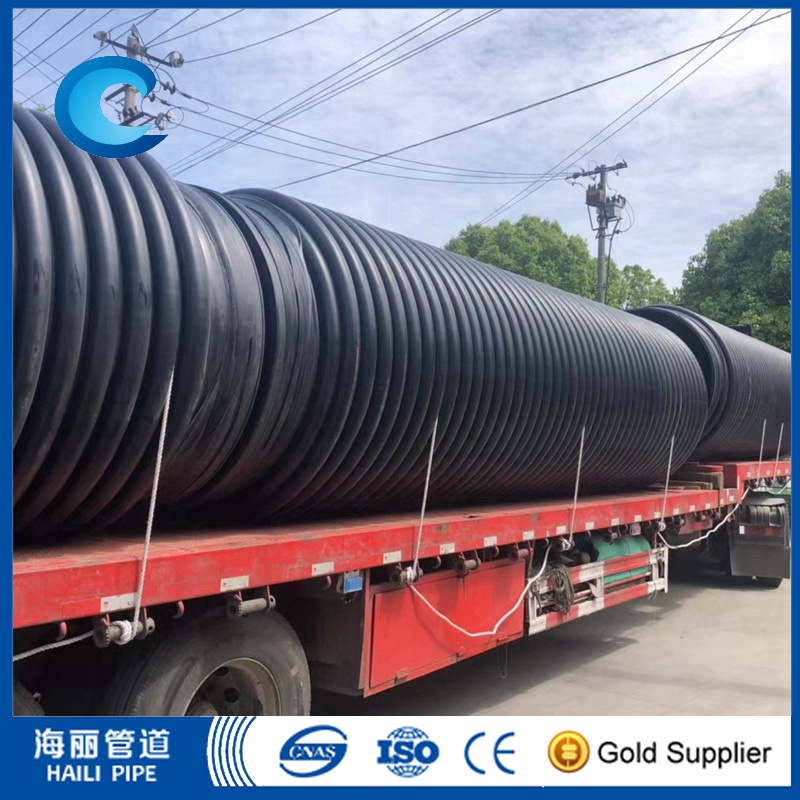
KRAH pipe wall structure
1. Structure PR
The inner wall of this structure is smooth, the outer wall is corrugated, the ring stiffness is high, and the weight is low. This structure is mainly used for the production of drainage, sewage pipes, etc. The specifications of the PP support pipe of this structure are 21, 25, 30, 34, 42, 54, 65, 75, 80, 90, 110mm
The inner wall of this structure is smooth, the outer wall is corrugated, the ring stiffness is high, and the weight is low. This structure is mainly used for the production of large-diameter drainage and sewage pipes. The PP support tube specifications for this structure are 54, 65, 75, 80 mm
2. Structure SQ
This kind of structure has smooth inner and outer walls, is supported by one or more layers of PP pipes, and has high ring stiffness. The PP support tube specifications for this structure are 34, 42, 54, 65, 75, 80 mm
3. Structure SP
When the pipes of all the above structures cannot meet the engineering requirements, the pipe wall structure can be flexibly combined according to the needs, so as to produce the pipes that meet the requirements. The inner and outer walls of this structure are smooth, supported by one or more layers of PP pipes, and the ring stiffness High, this structure is mainly used to produce large-diameter, high-ring stiffness drainage, sewage pipes, pipe fittings, storage tanks, inspection wells, etc. The PP support tube specifications for this structure are 34, 42, 54, 65, 75, 80 mm
KRAH pipe SP structure
4. Structure VW
This structure has smooth inner and outer walls and can be used for pipes with internal pressure.
5. Structure ST
The inner and outer walls of this structure are smooth, and the wall thickness of the pipe is gradually thickened from top to bottom. It is mainly used for vertical storage tanks.
The application field of KRAH pipe
The outer wall of KRAH pipe is smooth, the specification is φ300mmφ3000mm, depending on the conditions of use, the ring stiffness is divided into five grades, the highest is 16KN/m2, which can be adapted to the following 10% concentration in the pickling solution.
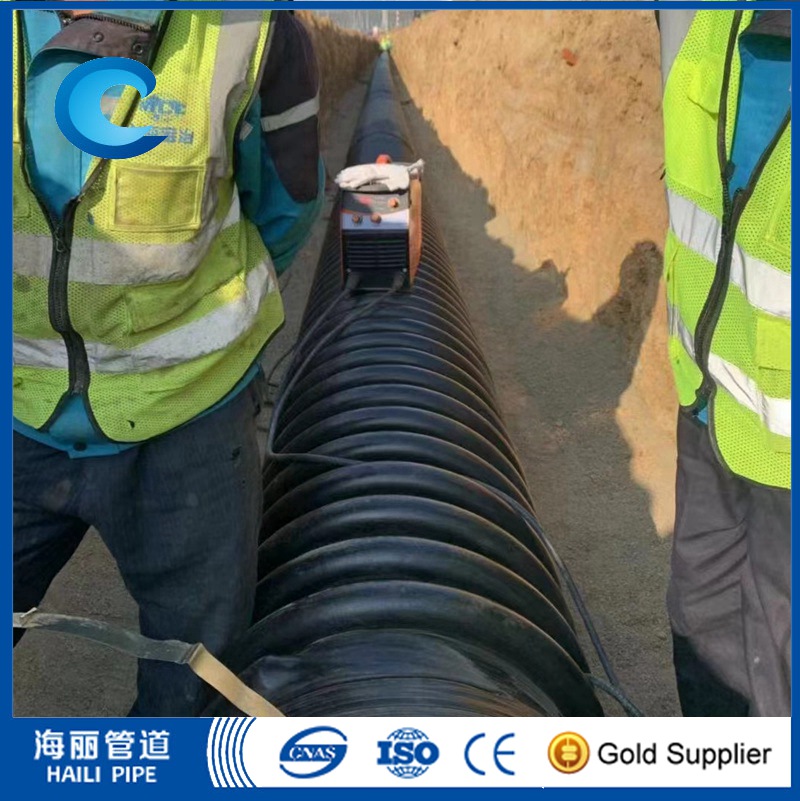
1. Sewage system
Various wall structures and pipes of thermal structure wall wound pipes, inspection wells, and pipe fittings can be used in advanced shallow drainage systems due to their reliable connection performance.
KRAH pipe can be used in sewage system
2. Drainage system
For discharging liquid and gaseous substances into rivers or seas. The thermal structure wall wound pipe has the advantages of light weight, safety, reliable connection, corrosion resistance and high ring stiffness, so the use of the thermal structure wound pipe has great advantages.
KRAH pipe can be used in drainage system
3. Tanks and containers
Pipes made of polyethylene or polypropylene can be used to produce vertical or horizontal storage tanks and have the following advantages.
Suitable for grain storage; acid and alkali resistance; high strength; 100 % reliable; system integrity; double flat walls do not leak.
KRAH pipe can be used for storage tanks and containers
4. Pipeline repair
The use of the "liner in pipe" approach to refurbish damaged pipelines is increasingly important
KRAH pipe can be used for pipeline refurbishment
5. Special application
The thermally wound wall-wound pipe can also be used for special purposes like ventilation, channels, etc.
Advantages of KRAH pipe
1. The raw materials meet the national environmental protection requirements, and the non-polluting production process is a green and environmentally friendly product.
2. The winding is made of thermoformed steel sheet, and the quality of the welding seam of the melting tube is high.
3. Good flexibility, improve the earthquake resistance and disaster reduction ability of public facilities.
4. System accessories are equipped with various matching pipe fittings and manholes, and the pipes can be assembled into a complete system.
5. Drainage with superior circulation performance, smooth inner wall of the pipe, smaller specific friction, flow rate and flow.
6. Anti-corrosion, anti-aging, long service life, good wear resistance and toughness of elastic tube, good chemical stability, various acid and alkali corrosion ability, ensure more than 50 years of service life.
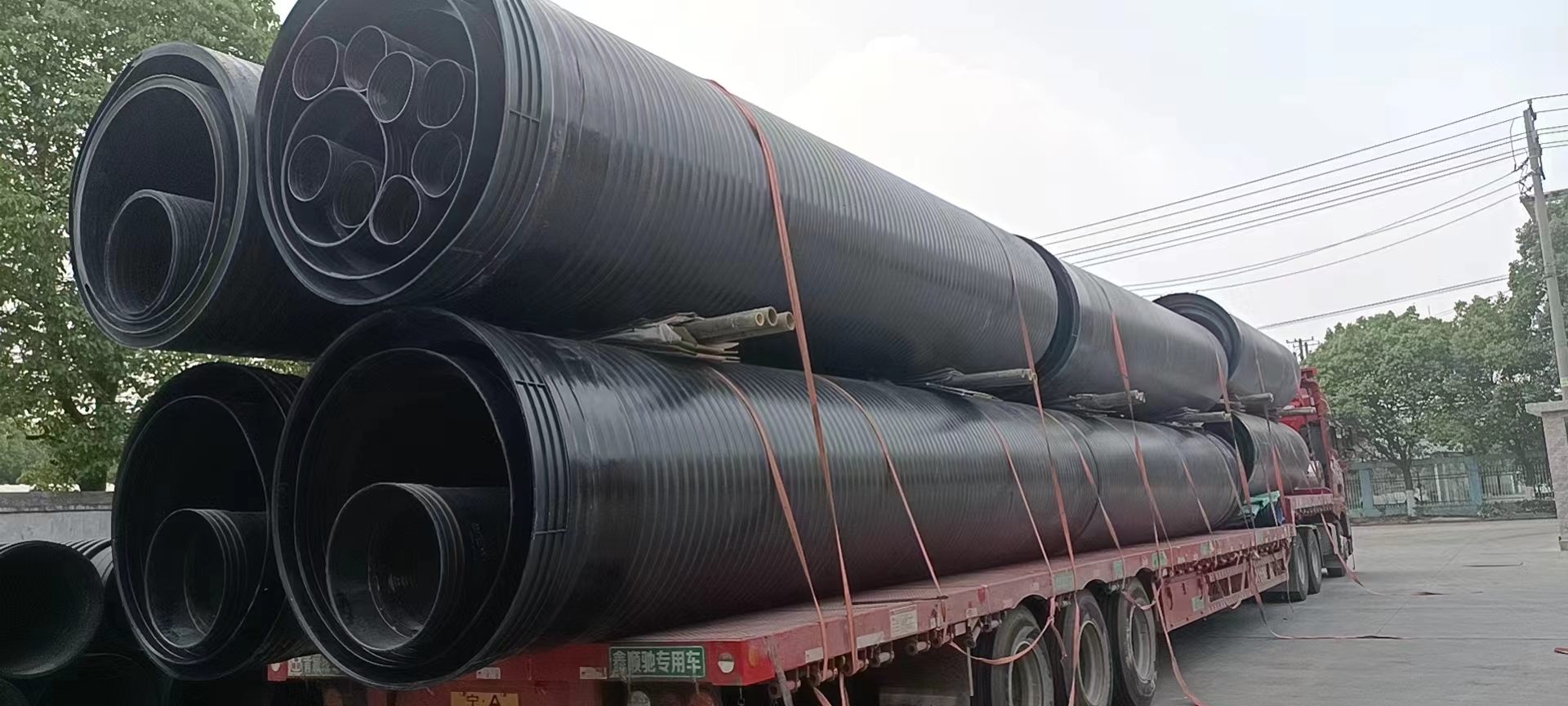








659.webp)
210.webp)
328.webp)

294.webp)
476.webp)


